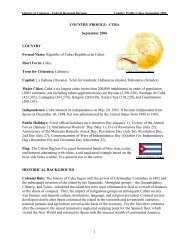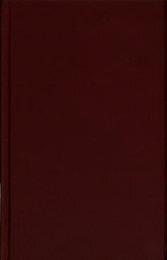Anton Webern's Six Pieces for Ocrhestra, op. 6, Arrangement for ...
Anton Webern's Six Pieces for Ocrhestra, op. 6, Arrangement for ...
Anton Webern's Six Pieces for Ocrhestra, op. 6, Arrangement for ...
You also want an ePaper? Increase the reach of your titles
YUMPU automatically turns print PDFs into web optimized ePapers that Google loves.
evision of 1928, the second orchestral version clearly stands apart from both the<br />
original and chamber versions. Or, to put it differently; in spite of its drastic<br />
instrumental reduction, the Verein version is closer to the original score, not only in<br />
time, but also with regard to its "dramaturgy of color," than the version of 1928. It is<br />
equally clear, however, that already in the chamber version Webern aimed toward<br />
the same ideal of greater economy in the use of expressive means as in the 1928<br />
orchestral version, about which he commented: "Everything extravagant is now cut<br />
(alto flute, six trombones <strong>for</strong> a few measures, and so on). Now I can represent all<br />
this much more simply." 32 For example, both in the chamber version and in the<br />
revised orchestral version, Webern reduced the scoring (especially by omitting<br />
unusual instruments). He also abandoned some playing techniques which alter the<br />
original sound (e.g., col legno, am Steg, Flatterzunge), and did away with the<br />
characteristic expression marks (e.g., "höchst ausdrucksvoll," "äusserts zart,"). 33<br />
Thus the chamber version of <strong>op</strong>. 6 marks an important intermediate stage between<br />
the original version of <strong>Webern's</strong> works and the revised ones of the 1920s. It<br />
suggests that the latter profited from his work in the Verein, particularly from his<br />
experience with "soloistic instrumentation" and his renouncing of "sensuous aids."<br />
<strong>Webern's</strong> artistic evolution was characterized, among other things, by an aesthetic<br />
shift from an "expressionistic" concept of sonority toward one determined by the<br />
"classicist" ideal of "Fasslichkeit." 34 It is not least with regard to this aspect of his<br />
evolution that the chamber version of <strong>Webern's</strong> <strong>Six</strong> <strong>Pieces</strong>, <strong>op</strong>. 6, deserves our<br />
attention.<br />
1 Letter from Alban to Helene Berg of July 1, 1918; published in Alban Berg: Briefe an<br />
seine Frau (Munich: Albert Langen and Georg Müller, 1965), pp. 363f.<br />
2 Letter to Heinrich Jalowetz of Nov. 9, 1918; Heinrich Jalowetz Collection, Paul Sacher<br />
Foundation.<br />
3 Regarding the history and impact of the Verein, see Judith Karen Melbach, "Schoenberg's<br />
'Society <strong>for</strong> Musical Private Per<strong>for</strong>mances,' Vienna 1918-1922: A Documentary Study" (Ph.<br />
D. diss. University of Pittsburgh, 1984); Joan Allen Smith, Schoenberg and His Circle: A<br />
Viennese Portrait (New York: Schirmer, 1986), pp. 81-102; and "Schoenberg's Verein für<br />
musikalische Privataufführungen" in Musik-Koncepte 36, ed. Heinz-Klaus Metzger and<br />
Rainer Riehn (Munich: Edition Text u. Kritik, 1984). All three publications contain<br />
complete concert programs.<br />
4 Letter to Heinrich Jalowetz, December 23, 1919; Heinrich Jalowetz Collection, Paul<br />
Sacher Foundation.<br />
5 Ibid.<br />
6 Cf. Hans and Rosaleen Moldenhauer, <strong>Anton</strong> von Webern: A Chronicle of His Life and<br />
Work (New York: Kn<strong>op</strong>f, 1979), p. 235.



![Albert Einstein Papers [finding aid]. Library of Congress. [PDF ...](https://img.yumpu.com/21604228/1/190x245/albert-einstein-papers-finding-aid-library-of-congress-pdf-.jpg?quality=85)





![American Colony in Jerusalem Collection [finding aid]. Library of ...](https://img.yumpu.com/17941275/1/190x245/american-colony-in-jerusalem-collection-finding-aid-library-of-.jpg?quality=85)



![Piccard Family Papers [finding aid]. - American Memory - Library of ...](https://img.yumpu.com/17941234/1/190x245/piccard-family-papers-finding-aid-american-memory-library-of-.jpg?quality=85)


